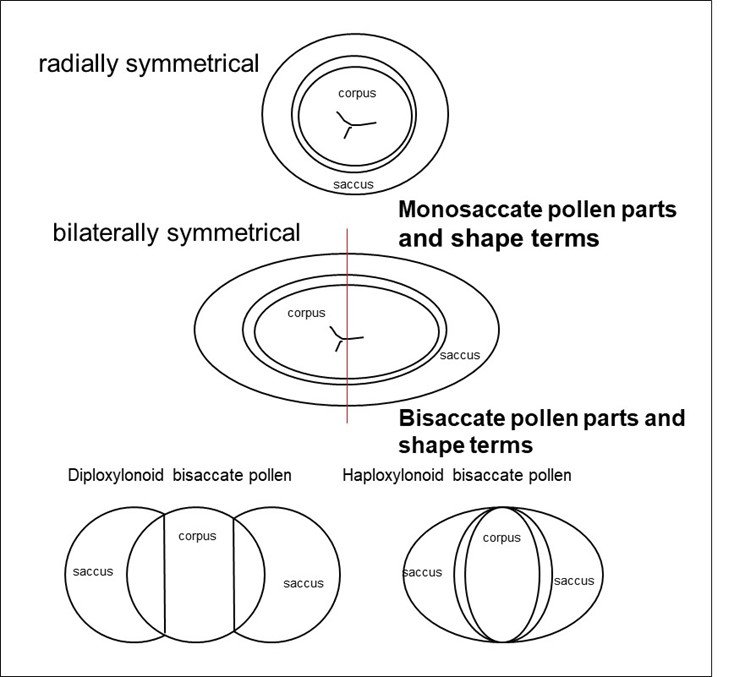Taxonomic keys
Taxonomic keys – to help in the identification of species – are a vital tool for palaeontologists and palynologists learning their trade, or for experienced palaeontologists starting in a new area. While they can’t replace the academic expert, they can imitate the expert’s thinking processes and decisions. They can also be useful for students and for standardising practical taxonomy in environments where lots of palynologists work together, for example in companies.
In palaeontology, an identification key or taxonomic key can be in the form of a printed series of notes and instructions that help you identify a palynomorph or fossil, perhaps at genus or species level. Identification keys are also used in many other scientific and technical fields to identify or diagnose diseases, minerals, or archaeological artifacts.
Most keys provide a fixed sequence of identification steps, each with multiple alternatives, the choice of which determines the next step. When the key stage has two alternatives, the stage is dichotomous, when there are more choices, the stage in the key is polytomous.
At each step, the user has to make a choice about the characters of the fossil being identified. In Palaeozoic palynology there are a range of possible starting points and so the person using the key has to know something about the morphology of the range of palynomorphs that might be encountered. In keys that I’ve designed for Middle Eastern Carboniferous - Permian palynology, there are a range of palynomorphs that might be encountered, whether pollen or spores (Fig. 1).
Fig. 1 Range of palynomorphs that might be encountered in the Carboniferous - Permian of the Middle East
Taking pollen to begin with, you may be faced with a decision over whether the palynomorph that you see is monosaccate or bisaccate - whether it has a single enveloping saccus, or two sacci (Fig. 2).
Fig. 2. Basic morphology of monosaccate and bisaccate pollen
If this decision can be made, then the user can graduate to a more complex key that allows a series of decisions within the broad class of monosaccate or bisaccate pollen. Of course this is not always as easy as it looks, because it is possible for saccate pollen to have characters that look both monosaccate and bisaccate at the same time, for example the genus Caheniasaccites. But a good key should allow the incorporation of even these ‘cross-over’ taxa so that they are not missed out.
Assuming a robust decision has been made to move to the monosaccate pollen (for example), we can proceed to the key below (Fig. 3). This key deals with monosaccate pollen leading the user to generic and species level determinations by taking a series of dichotomous and polytomous steps, beginning with a decision over whether the monosaccate pollen is bilaterally symmetrical or radially symmetrical.
Fig. 3. Monosaccate pollen key
The next choice is polytomous, with the user deciding on the pattern of intexinal folds, patterns on the corpus, or characteristics of the laesurae. Eventually the user should end up at a genus or species.
If, however, the user has taken the ‘bisaccate route’ by determining that their pollen grain has two sacci rather than one, they can move to a bisaccate key (Fig. 4).
Fig. 4. Bisaccate pollen key
The first decision to be made is to decide whether the pollen is diploxylonoid or haploxylonoid (see Fig. 2), and following this, characters such as position of taeniae and number of taeniae become important. This leads the user to decisions at the genus and species level.
Over a period of almost 25 years of palynological taxonomy, I have developed keys for all the main types of palynomorphs that might be encountered in Middle Eastern Carboniferous - Permian from formations as widespread as the Umm Irna Formation in Jordan, the Saad and Arqov formations of the Negev, the Berwath, Unayzah and Khuff formations of Saudi Arabia and the Gulf, the Harur, Raha, and Ga’ara formations in Iraq, the Faraghan Formation in Iran, the Markada Formation in Syria, the Akbarah and Kuhlan formations of Yemen, and the Tobra and Dandot formations of Pakistan
Such keys are not perfect but I have used them to good effect in university teaching, helping students to quickly gain a grasp of the basics of taxonomy, not replacing the need, of course, for students to use taxonomic literature (for example published diagnoses). I’ve also used such keys to help in standardising taxonomic procedures in in-house company environments where it is important that palynologists and palaeontologists working on practical stratigraphic problems all use the same concepts for genera and species. This makes taxonomy more reliable and therefore correlation and stratigraphy more reliable.
In conclusion taxonomic keys are a useful tool for palaeontologists and palynologists. They can imitate an expert’s thinking processes and decisions and guide students learning how to determine genera and species. They can also help to standardising practical taxonomy in environments where lots of palynologists work together, for example in companies.
Prof Mike Stephenson is available for palynological consultancy and training.



